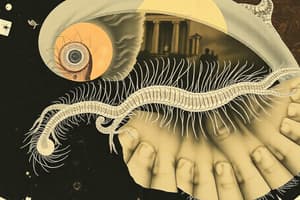Podcast
Questions and Answers
What are the two main types of development mentioned in the text?
What are the two main types of development mentioned in the text?
- Metamorphic and non-metamorphic
- Rapid and slow
- Embryonic and post-embryonic
- Direct and indirect (correct)
What are the ecological aspects associated with metamorphosis?
What are the ecological aspects associated with metamorphosis?
- Changes in social structure and communication
- Changes in body size and coloration
- Changes of habitat, food, and behaviors (correct)
- Changes in reproductive strategy
What is the difference between primary larvae and secondary larvae?
What is the difference between primary larvae and secondary larvae?
- Primary larvae are found in marine environments, while secondary larvae are found in terrestrial environments
- Primary larvae are smaller than secondary larvae
- Primary larvae have dramatically different body plans than the adult form, while secondary larvae have the same basic body plan as the adult (correct)
- Primary larvae have longer development times than secondary larvae
What are the main changes involved in metamorphosis?
What are the main changes involved in metamorphosis?
What is the role of metamorphosis in the life cycle of animals?
What is the role of metamorphosis in the life cycle of animals?
Flashcards are hidden until you start studying
Study Notes
Developmental Types
- There are two main types of development: direct development and indirect development.
- Direct development involves a series of gradual changes from egg to adult, with no distinct larval stage.
- Indirect development involves a distinct larval stage that undergoes metamorphosis to become the adult form.
Ecological Aspects of Metamorphosis
- Metamorphosis is often associated with a change in habitat or environment.
- This change can provide a selective advantage, allowing the species to adapt to new ecological niches.
- Metamorphosis can also lead to a change in feeding habits, diet, or predator avoidance strategies.
Primary and Secondary Larvae
- Primary larvae are the immediate offspring of the adult form, often resembling small versions of the adult.
- Secondary larvae are the result of a subsequent transformation, often differing significantly from the adult form.
- Primary larvae may undergo a series of molts before becoming secondary larvae.
Changes Involved in Metamorphosis
- Morphological changes: transformations in body shape, size, and structure.
- Physiological changes: changes in bodily functions, such as the development of new organs or the modification of existing ones.
- Behavioral changes: alterations in behavior, such as changes in feeding habits or habitat selection.
Role of Metamorphosis in Life Cycle
- Metamorphosis plays a crucial role in the life cycle of animals, allowing them to adapt to new environments and ecological niches.
- It enables species to overcome limitations imposed by their larval stage, such as limited mobility or feeding capabilities.
- Metamorphosis is essential for the survival and reproductive success of many species.
Studying That Suits You
Use AI to generate personalized quizzes and flashcards to suit your learning preferences.




